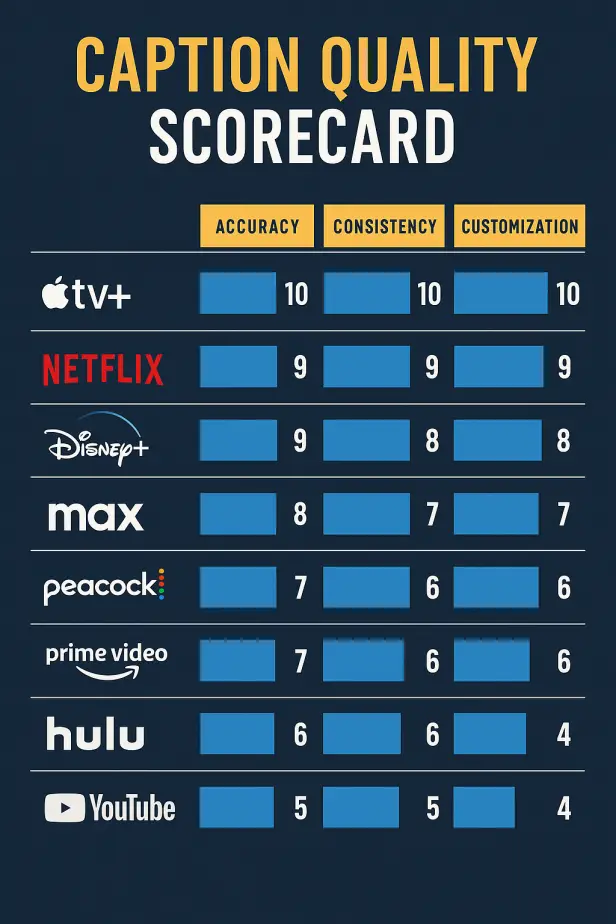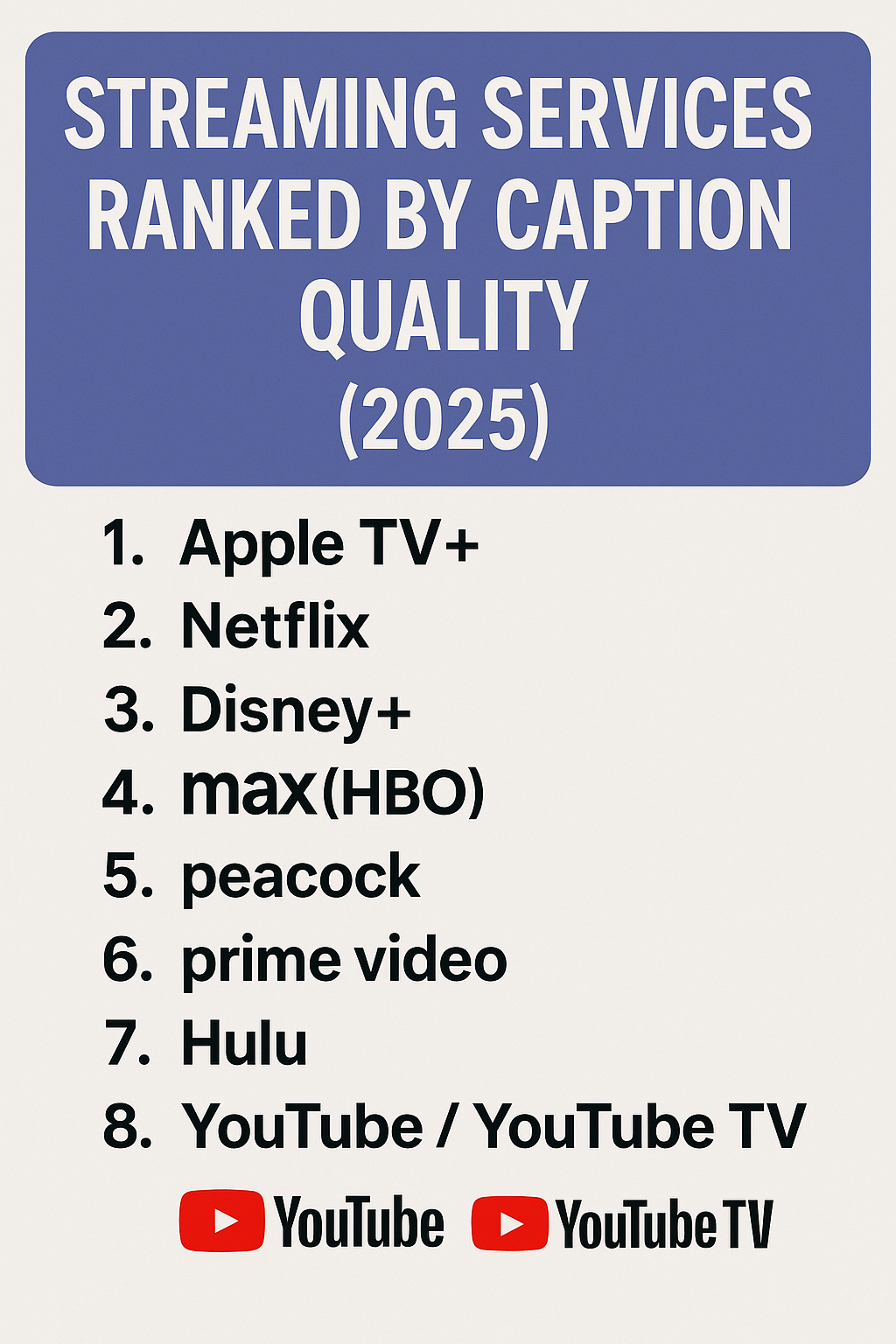As an audiologist, I don’t just spend my time fitting hearing aids—I also test and rate caption services. Why? Because captions often make the difference between truly enjoying a movie and missing the storyline. Even with advanced hearing aids, many patients still struggle to follow TV dialogue. Captions can restore that clarity, if the service does them well.
Not all streaming platforms handle captions equally. Some offer crystal-clear, customizable text, while others frustrate users with poor timing or hard-to-read subtitles. Below, I rank the major streaming platforms by caption quality, consistency, and ease of use so you can choose the best one for your needs.
Quick Rankings (Best to Worst)
- Apple TV+ – Best captions overall; easy to customize
- Netflix – High standards, detailed captions, great controls
- Disney+ – Solid captions across the board
- Max (HBO) – Reliable with simple controls
- Peacock – Customizable and improving
- Prime Video – Mixed; varies depending on provider
- Hulu – Good captions, but sync issues are common
- YouTube / YouTube TV – Auto-captions make it hit-or-miss
What Makes a Good Caption?
The FCC outlines four key rules for caption quality:
- Accurate – Captions must match the spoken words.
- Synchronous – They should appear at the same time as the audio.
- Complete – No dialogue or important sound should be left out.
- Well-placed – They must not block faces or on-screen text.
For hearing aid users, SDH (Subtitles for the Deaf and Hard of hearing) are especially valuable. They include sound cues like [music playing] or [door creaks]—details hearing aids may not always make clear.
Service by Service: What You Need to Know
Apple TV+ (Best Overall)
Why it’s great: Professional captions with full customization—size, font, color, and background. Once you set your style, it works across devices.
Tip: Go to Settings → Accessibility → Subtitles & Captioning → Style to make captions larger or higher contrast.
Netflix
Why it’s great: Netflix enforces strict captioning rules, so you get accurate text, speaker labels, and sound effects.
Tip: Pause your show, go to Settings, and adjust size and style. The website version has the most options.
Disney+
Why it’s good: Consistent captions throughout its library. Easy to turn on for family shows.
Tip: Tap the keyboard icon while watching to enable captions.
Max (HBO)
Why it’s good: Nearly all content includes captions, with a simple toggle in the player.
Peacock
Why it’s good: Customization options for font, color, and size make captions easier to personalize.
Prime Video
Why it’s mixed: Amazon Originals are usually solid, but add-on channels and rentals can be inconsistent.
Hulu
Why it’s frustrating: Captions often fall out of sync, especially on some devices. Restarting the app or toggling captions off and on usually helps.
YouTube / YouTube TV
Why it’s last: Auto-generated captions can be 30–40% wrong. Look for creators who upload their own captions for better accuracy.
Quick Comparison Table
| Service | Customization | Quality | My Take |
|---|---|---|---|
| Apple TV+ | Excellent | Always strong | Best choice overall |
| Netflix | Very good | Top quality | Great for detailed cues |
| Disney+ | Good | Strong | Reliable for family use |
| Max | Good | Reliable | Easy access |
| Peacock | Good | Improving | Nice customization |
| Prime Video | Varies | Mixed | Check before renting |
| Hulu | Basic | Sometimes glitchy | May need resets |
| YouTube / YTTV | Basic | Often inaccurate | Depends on uploader |

Real-Life Patient Stories
- Linda (72, Oticon RIC aids): Apple TV+ with high-contrast captions let her turn down TV volume by 8 dB. She now streams audio directly using a Bluetooth transmitter.
- Marcus (58, cochlear implant): Netflix’s speaker labels and sound cues helped him follow action scenes more easily than with sound alone.
- Ava (34, auditory processing disorder): Switched from Hulu to Disney+ due to caption lag, making family viewing much less stressful.
Tips for Hearing Aid Users
- Start with the main guide: How to Hear TV and Movies Clearly.
- Upgrade sound: TV speakers designed for dialogue or budget soundbars with speech enhancement.
- Stream directly to your aids with a Bluetooth transmitter.
- Improve the room: Set up your living room for clearer sound.
- Go hands-free: Use Alexa or Google Home for quick caption control.
Bottom Line
If captions are essential to your TV enjoyment, Apple TV+ and Netflix are the clear leaders. Disney+ and Max are steady choices, while Prime, Hulu, and YouTube may require patience.
The good news is every major service does offer captions—you just need to know how to switch them on, adjust them, and pick the service that best matches your needs.

